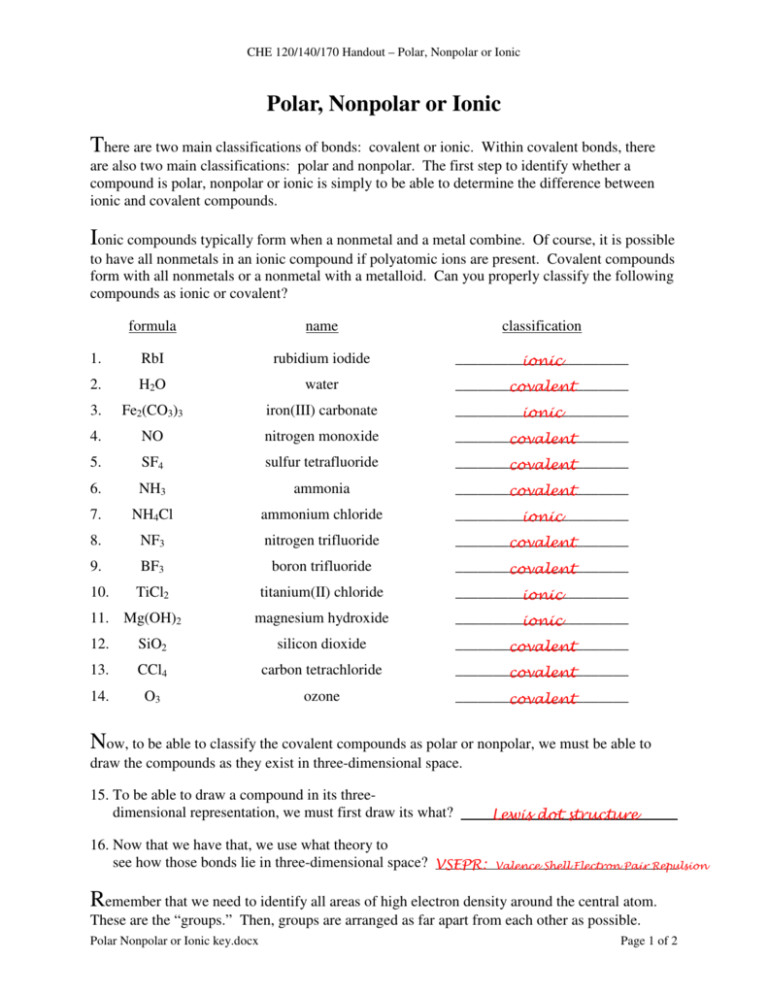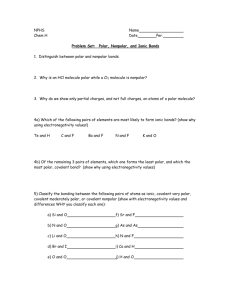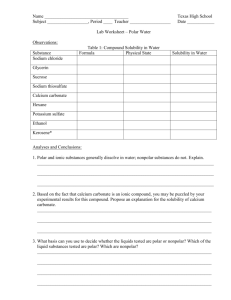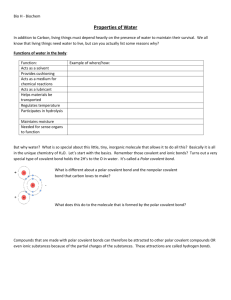Polar Nonpolar or Ionic key
advertisement

CHE 120/140/170 Handout – Polar, Nonpolar or Ionic Polar, Nonpolar or Ionic There are two main classifications of bonds: covalent or ionic. Within covalent bonds, there are also two main classifications: polar and nonpolar. The first step to identify whether a compound is polar, nonpolar or ionic is simply to be able to determine the difference between ionic and covalent compounds. Ionic compounds typically form when a nonmetal and a metal combine. Of course, it is possible to have all nonmetals in an ionic compound if polyatomic ions are present. Covalent compounds form with all nonmetals or a nonmetal with a metalloid. Can you properly classify the following compounds as ionic or covalent? formula name classification 1. RbI rubidium iodide _______________________ ionic 2. H2O water _______________________ covalent 3. Fe2(CO3)3 iron(III) carbonate _______________________ ionic 4. NO nitrogen monoxide _______________________ covalent 5. SF4 sulfur tetrafluoride _______________________ covalent 6. NH3 ammonia _______________________ covalent 7. NH4Cl ammonium chloride _______________________ ionic 8. NF3 nitrogen trifluoride _______________________ covalent 9. BF3 boron trifluoride _______________________ covalent 10. TiCl2 titanium(II) chloride _______________________ ionic magnesium hydroxide _______________________ ionic 11. Mg(OH)2 12. SiO2 silicon dioxide _______________________ covalent 13. CCl4 carbon tetrachloride _______________________ covalent 14. O3 ozone _______________________ covalent Now, to be able to classify the covalent compounds as polar or nonpolar, we must be able to draw the compounds as they exist in three-dimensional space. 15. To be able to draw a compound in its threedimensional representation, we must first draw its what? 16. Now that we have that, we use what theory to see how those bonds lie in three-dimensional space? VSEPR: Lewis dot structure Valence Shell Electron Pair Repulsion Remember that we need to identify all areas of high electron density around the central atom. These are the “groups.” Then, groups are arranged as far apart from each other as possible. Polar Nonpolar or Ionic key.docx Page 1 of 2 CHE 120/140/170 Handout – Polar, Nonpolar or Ionic Below you will see that the VSEPR shapes for the covalent compounds on the front of this sheet have already been drawn for you. Your job is to determine if the compound is polar or nonpolar. Remember that a nonpolar compound can have polar bonds, but if a compound has no polar bonds it cannot be polar. For each molecule, draw the appropriate vector by each polar bond; then, if the molecule is polar, draw a vector (and circle it) showing the overall polarity of the molecule. If the molecule is nonpolar, write “nonpolar” by it. O 17. F H H B F F 22. N nonpolar O 18. 23. O O nonpolar F F S Cl F F 19. Si C Cl Cl Cl 24. nonpolar N H H H 20. O O O 25. nonpolar N F F (no polar bonds) F 21. Polar Nonpolar or Ionic key.docx Page 2 of 2





